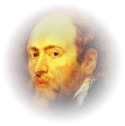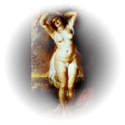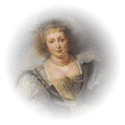Peter Paul Rubens (1577-1649) is often called "Prince of Baroque Painters". His influence on the painters of his century was enormous, as it was on sculpture and architecture. He was a versatile genius and rivaled in inventive power the great minds of the Baroque. He was a humanist and classical archaeologist, a sumptuous designer of religious, historical and allegorical canvases and a supreme master in ‘pure’ landscape. Rubens left about three thousands of works which are scattered through collections and museums across the world.
Rubens went far beyond his predecessors, and attracted and fascinated his successors,
from Van Dyck to Watteau, Boucher to Delacroix and from Renoir and early Cezanne to
Matisse. His profane and mythological compositions fascinated
his successors so much that Delacroix called him the "Homer of Painting".
He built up and managed his Antwerp studio that was famous throughout the continent,
where he trained his assistants and collaborators, who later became famous painters as
Anthony van Dyck, Jordaens, Snyders and Cornelis de Vos,
and many others less famous. No artist has ever been as well educated as Rubens. He was a genius of
his time. Hi was not only a painter, he was also a successful diplomat, who earned
a European-wide reputation after the peace-negotiations between England and Spain in 1630.
His great intelligence, talent, knowledge of Classical Antiquity, diplomatic and organizing
skills, and the divergence of attention impressed and attracted his contemporaries attention.
Otto Sperling, doctor to the Danish king, wrote about his visit he made to Rubens' studio
in Antwerp:
"the master was working on a canvas while listening to a reading of Tacitus and simultaneously
dictating a letter. Since we did not dare interrupt him, he himself addressed us, while
continuing to paint, listen to the reading and dictate his letter".
 In his style he successfully united the features of Northern and Flemish art with t
hose of Italy. Moreover, he brought to the High Renaissance art his vivid
dynamism, realism and naturalism which the French critic Roger de Piles in
1677 commented in these words:
In his style he successfully united the features of Northern and Flemish art with t
hose of Italy. Moreover, he brought to the High Renaissance art his vivid
dynamism, realism and naturalism which the French critic Roger de Piles in
1677 commented in these words:
"He was so strongly persuaded that the aim of the painter was to imitate nature perfectly, that he did nothing without consulting her, and there has never been a painter who has observed and who has known better than he how to give to objects their true and distinctive character ... And he carried this knowledge so far, with a bold but wise and skillful exaggeration of these characteristics, that he rendered painting more alive and more natural, so to speak, than nature itself."
He was not only one who criticized Rubens attentiveness to nature. Bellori found particularly distressing that the artist, in working form the best models of the past, transformed them so drastically. He wrote:
"Though he had the highest admiration for Raphael and the antique, he never imitated either in any part, and though he may have wished to follow the lineaments of the statues of Apollo, of Venus, or of the Gladiator, he altered them so much by his style that he left no more form or vestige of these statues by which they might be recognized".
On the other hand, Rubens in his treatise for young painters "On the imitation of statues" warned them against reproducing their cold and stony lustre" "Those who, instead of painting flesh, only represent marble in colour, offer an affront to Nature." "Figures should appear to be animated by the pulse of life" toughed he. "The pulse of life" is a quintessence of his work "Andromeda" inspired by the ancient myth. The world of ancient myths has been explored and painted in 1400s but it was only in sixteenth century that its full dramatic, poetic and sensual potential was realized.
 Andromeda was a daughter of the king of Ethiopia, Cepheus.
Her beauty was known in all his kingdom. Her mother, Cassiopea, claimed
that her daughter was even more beautiful than all the Nereids.
In jealousy Nereids asked Poseidon to send a monster to waste Cepheus's kingdom.
An oracle foretold that the country would be spared if Andromeda,
whose beauty was a course of their mischief, were given to the monster.
The people of Ethiopia forced Cepheus save them by sacrificing
his daughter. In this stage, Andromeda chained to a rock to be devoured
by a sea-monster.
Andromeda was a daughter of the king of Ethiopia, Cepheus.
Her beauty was known in all his kingdom. Her mother, Cassiopea, claimed
that her daughter was even more beautiful than all the Nereids.
In jealousy Nereids asked Poseidon to send a monster to waste Cepheus's kingdom.
An oracle foretold that the country would be spared if Andromeda,
whose beauty was a course of their mischief, were given to the monster.
The people of Ethiopia forced Cepheus save them by sacrificing
his daughter. In this stage, Andromeda chained to a rock to be devoured
by a sea-monster.
Rubens has turned this scene into high drama by setting it in the swiftly swirled background.
Her attractive and sensuous body is placed in the center of the canvas surrounded by ominous sky and rough sea.
The dark, heavy sky is filled with lightning and quasi-vaporous form of monster appears at her left side.
To intensify dramatic effect of the scene Rubens applied the efect of light. The darkness of the space is pirced
by the strong shaft of a supernatural light that illuminate her body giving it rigid, semi-lifeless look.
The restless movement of the body suggests that she is trying to free herself from the chain.
Dynamic, quick turn of her head toward the left (where the monster apperars) emphasizes the drama of her situation.
With the true virtuosity Rubens rendered the expressions of feellings and states of the mind.
Her face express the horror of fear, the loneliness that besets her at this particular moment, as well as the feeling of abandonment.
She is not yet aware that she will be freed from her fate by the hero Perseus.
Ruben's rendering of anatomy of the woman body was so realistic, that it never allow us to forget the mind and hand of the crator. The exuberance of woman body express Ruben's own taste, his powerful individuality and sensibility. Prevailing in his works the woman's opulent form and taste for buxom nude was inspirered by his pasionate love to his first wife Isabella Brandt, and later to his second wife Helena Fourment. This unique exurbance, stage-management style of painting of naked women was given by some scholars a name "the Rubenesque", which was later expanded to cover his whole artistic creation.
 At the time of his second marriage Rubens was over fifty and his young second wife,
Helena Fourment was no older than his elder son. His unexpected decision Rubens
explained himself in the letter to Peiresec:
At the time of his second marriage Rubens was over fifty and his young second wife,
Helena Fourment was no older than his elder son. His unexpected decision Rubens
explained himself in the letter to Peiresec:
"I decided to remarry, for I have never been attracted to the abstinent life
of the celibate, and I told myself that, though we should award the crown to continence,
we may nevertheless enjoy legitimate pleasures and give thanks for them. I have chosen
a young woman of good (...) family, though everybody sought to convince me to make a
court marriage. But I was fearful of a vice inbred in the nobility, and especially
prevalent among noble women: vanity. So I chose someone who would never have to blush at
finding me brush in hand. All the truth is, I am to fond of my freedom to exchange it for the
embraces of an old woman."
List of major works by Peter Paul Rubens in chronological order:
| 1599-1600: | Adam and Eve |
| 1606: | Portrait of the Marchesa Brigida Spinola Doria |
| 1609-10: | Rubens with his wife Isabella Brant in a Honeysuckle Bower |
| 1610-11: | Annunciation |
| 1610-11: | The four philosophers (Julius Lipsius and his pupils) |
| 1610-11: | Susanna and the Elders |
| 1610-11: | The Elevation of the Cross (the triptych) |
| 1611-1614: | The Descent from the Cross(the triptych) |
| 1614-15: | Cupid making his bow (inspired by the work of Parmigianino from 1533-1534) |
| 1615: | The toilet of Venus |
| 1618: | The Union of Earth and Water |
| 1618-1619: | Castor and Pollux Abduct the Daughters of Leukyppos |
| 1618-1620: | The Battle of the Amazons |
| 1620-1621: | Perseus and Andromeda |
| 1628-1629: | Deborah Kip, Wife of Sir Balthasear Gerbier, and Her Children |
| 1635: | Bathsheba at the Fountain |
| 1636-1639: | The Fur Cloak (Helene Fourment) |
| 1637-1639: | Thre Three Graces |
| 1636-1640: | Rubens, His Wife Helena Fourment and Their Son Peter Paul |